
Hambledon is a rural scattered village in the Waverley borough of Surrey, situated south of Guildford. It is dominated by a buffer zone of fields and woodland, mostly south of the Greensand Ridge escarpment between Witley and Chiddingfold, having no dual carriageways or railways; however, it is bordered to the west by the Portsmouth Direct Line, and many of its small population are London commuters or retirees. Its main amenities are a church, a village pub, and the village shop and post office.

Mossley Hill is a suburb of Liverpool and a Liverpool City Council ward. Located to the south of the city, it is bordered by Aigburth, Allerton, Childwall, and Wavertree. At the 2001 Census, the population was 12,650, increasing to 13,816 at the 2011 Census.

Cross Houses is a village in Shropshire, England, the largest village in the Parish of Berrington. It is located on the A458 road and is 4 miles south east of Shrewsbury.

Greenbank is a residential district of south Edinburgh, Scotland. It is situated between the districts of Morningside and Oxgangs, i.e. slightly to the south-west of the heart of Morningside.
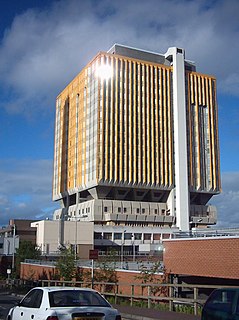
The Belfast City Hospital in Belfast, Northern Ireland, is a 900-bed modern university teaching hospital providing local acute services and key regional specialities. Its distinctive orange tower block dominates the Belfast skyline being the third tallest storeyed building in Ireland. It has a focus on the development of regional cancer and renal services. It is managed by Belfast Health and Social Care Trust and is the largest general hospital in the United Kingdom. In April 2020, due to the global coronavirus pandemic, the tower block was designated one of the UK's Nightingale Hospitals.

Billinge Hospital was a National Health Service facility in the Billinge Higher End district of the Metropolitan Borough of Wigan, Greater Manchester, England. It was managed by the 5 Boroughs Partnership NHS Trust.
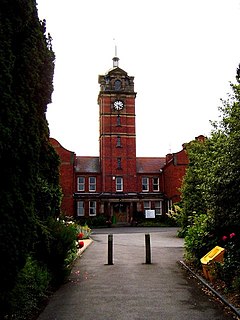
Wordsley Hospital was an NHS hospital located in Wordsley, near Stourbridge, West Midlands, England.
Greenbank is part of the city of Plymouth in the county of Devon, England.
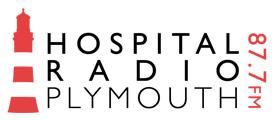
Hospital Radio Plymouth is a hospital radio station based in Plymouth, England. It provides entertainment to the patients of Derriford Hospital broadcasting via the internet and on 107.3fm. The station holds a long term restricted service licence granted by Ofcom, allowing it to broadcast on FM.

Battle Hospital was a National Health Service hospital in the town of Reading in the English county of Berkshire. The hospital was located on a large site between Oxford Road and Portman Road, in West Reading.

The neighbourhood of Pleasantville in St. John's, Newfoundland and Labrador is located in the east end of the city, directly north of the downtown. The neighbourhood extends from the north side of Quidi Vidi Lake northward to Newfoundland Drive, and is largely made up of apartment blocks.

Burton Road Hospital was a National Health Service hospital situated in Dudley, West Midlands, England.

New End Hospital was a hospital in Hampstead, north London. It was founded in 1869 as the infirmary for the Hampstead Union workhouse, and operated until 1986. The buildings have now been redeveloped as housing.

Southlands Hospital is a medical facility based in Shoreham-by-Sea, West Sussex, England, which serves people living in Shoreham itself as well as Worthing and other towns and villages along the south coast and in the inland areas of West Sussex. It is managed by the Western Sussex Hospitals NHS Foundation Trust.
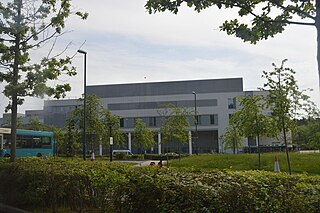
Tunbridge Wells Hospital is a large district general hospital in Pembury near Royal Tunbridge Wells, Kent, England, run by the Maidstone and Tunbridge Wells NHS Trust. The hospital is located on Tonbridge Road, around 0.5 kilometres (0.31 mi) to the north-west of Pembury, close to the A21 trunk road. It is surrounded by woodland on three sides.

Clatterbridge Hospital is a general hospital located on Clatterbridge Health Park in Bebington, Wirral, England. It is managed by Wirral University Teaching Hospital NHS Foundation Trust.
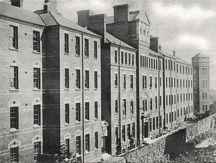
Paddington General Hospital was a health facility in Harrow Road, Paddington, London.
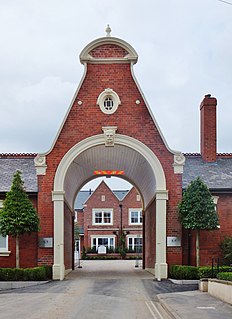
Westwood Hospital was a health facility in The Woodlands, Beverley, East Riding of Yorkshire, England. Both the original block and the gateway are Grade II listed buildings.

St John's Hospital was a health facility in Wood Street, Chelmsford, Essex. It was managed by Mid Essex Hospital Services NHS Trust.

The Edinburgh City Hospital was a hospital in Colinton, Edinburgh, opened in 1903 for the treatment of infectious diseases. As the pattern of infectious disease changed, the need for in-patients facilities to treat them diminished. While still remaining the regional centre for infectious disease, in the latter half of the 20th century the hospital facilities diversified with specialist units established for respiratory disease, ear, nose and throat surgery, maxillo-facial surgery, care of the elderly and latterly HIV/AIDS. The hospital closed in 1999 and was redeveloped as residential housing, known as Greenbank Village.





















